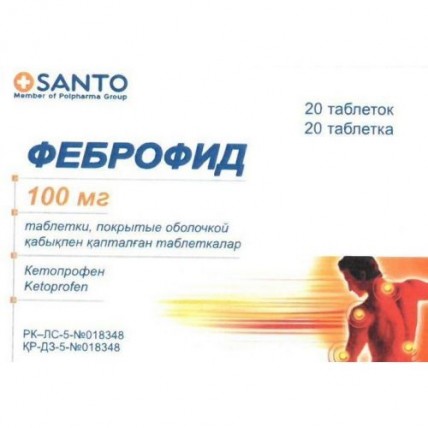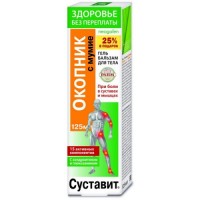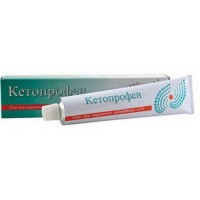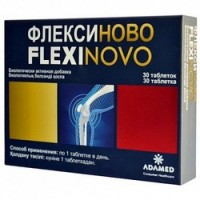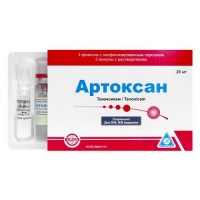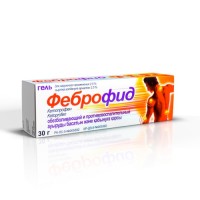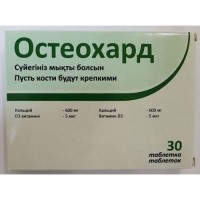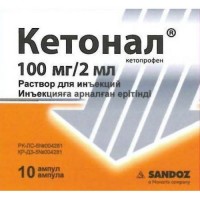Febrofid 20s 100 mg coated tablets
- $11.30
The instruction for medical use of FEBROFID medicine the Trade name of FEBROFID the International not patent name Ketoprofen Dosage Form of the Tablet, coated 100 mg Structure 1 tablet contains active agent: ketoprofen of 100 mg, excipients: microcrystalline cellulose, krospovidon, silicon dioxide colloidal anhydrous, magnesium stearate. structure of a cover (OPADRI II 33G32852 Yellow): gipromelloza, lactoses monohydrate, triacetin, a macrogoal 3000, quinolinic yellow E 104, gland (III) oxide red E 172, gland (III) oxide yellow E 172, the titan E 171 dioxide the Description of the Tablet of round shape, with a biconvex surface, coated light yellow color. Pharmacotherapeutic group Anti-inflammatory and antirheumatic drugs. Non-steroidal anti-inflammatory drugs. Propionic acid derivatives. Ketoprofen. The ATX M01AE03 code the Pharmacological Pharmacokinetics Absorption Ketoprofen properties is well soaked up from digestive tract. After intake of a tablet of ketoprofen in a dose of 100 mg the maximum concentration in blood plasma is reached approximately in 60 - 90 minutes. The bioavailability of ketoprofen is about 90%. Food does not affect the general biological availability of ketoprofen. Distribution Ketoprofen for 99% contacts proteins of plasma, generally albumine. Ketoprofen gets into synovial fluid and a cavity of a joint: articulate bag, synovial membrane and circumarticular fabrics. Ketoprofen gets also into cerebrospinal liquid and through a placental barrier. After repeated introduction, ketoprofen does not kumulirutsya in an organism. Metabolism Ketoprofen biotransformirutsya in a liver, generally by conjugation with glucuronic acid and partially by hydroxylation. Metabolites pharmacological are inactive. Removal Both ketoprofen, and its metabolites are removed generally with urine. After intake of ketoprofen inside approximately from 75% to 90% of a dose it is removed with urine in 5 days. Less than 1% of ketoprofen are removed in not changed look. Removal with a stake makes from 1% to 8%. Elimination half-life of ketoprofen makes about 2 hours. The pharmacodynamics Febrofid, derivative fenilpropionovy acid, belongs to group of non-steroidal anti-inflammatory drugs. Possesses anti-inflammatory, analgeziruyushchy, febrifugal and anti-aggregation action. The mechanism of its action is caused by oppression of cyclooxygenase, the enzyme which is responsible for synthesis of prostaglandins. Febrofid is also an antagonist of bradykinin. Inhibits synthesis of leukotrienes, reduces aggregation of thrombocytes of blood, has the stabilizing impact on lizosomalny membranes. Indications In complex therapy of inflammatory and inflammatory and degenerative and metabolic diseases of joints (a pseudorheumatism, an osteoarthrosis, spondylarthrites, psoriasis arthritis, reactive arthritis, gouty arthritis, a pseudogout, etc.) - extraarticular rheumatism: a tendovaginitis, a bursitis, a capsulitis, etc. - a pain syndrome of various etiology: a headache, migraine and migrenepodobny pain, a toothache, algodismenoreya, pain in metastases in a bone at patients with oncological diseases, postoperative and posttraumatic pains, neuralgia, myalgias of various genesis, an ischialgia. Febrofid tablets accept a route of administration and doses without chewing, washing down with enough water, at meal time or right after meal. Febrofid of a tablet of 100 mg: appoint 1-2 tablets a day, once or in two steps. At short symptomatic therapy: on 1 tablet 3 times a day. Duration of treatment is defined by the doctor. Side effects Often: - dispeptic phenomena, loss of appetite, nausea, vomiting, meteorism, abdominal pains, constipation Infrequently: - diarrhea, gastritis - a headache, dizziness, drowsiness - skin rash Seldom: - hemorrhagic anemia, a leukopenia - a depression, insomnia, nervousness, paresthesia - deterioration in sight - sonitus - stomatitis, ulcer of stomach and duodenum - hepatitis, increase in level of transaminases and bilirubin - increase in body weight - an acute anaphylaxis - a bronchospasm, an attack of bronchial asthma Very seldom: - exacerbation of colitis and Crohn's disease, gastrointestinal bleedings - an abnormal liver function - an acute renal failure, tubulointerstitsialny nephrite - a hypernatremia, a hyperpotassemia - an agranulocytosis, thrombocytopenia - spasms - heart failure - arterial hypertension - rhinitis - a photosensitization, a Quincke's edema, bullous rash, including Stephens-Johnson's syndrome, a toxic epidermal necrolysis of the Contraindication - individual hypersensitivity to ketoprofen, aspirin or other non-steroidal anti-inflammatory drug (instructions in the anamnesis on asthma, a bronchospasm, urticaria or rhinitis connected with intake of acetylsalicylic acid) - heavy heart failure - digestive tract diseases in an aggravation phase (gastritis, a peptic ulcer of a stomach, the instruction in the anamnesis on gastrointestinal bleedings, education or a perforation of ulcers) - bleedings (gastrointestinal, cerebrovascular or other active bleedings) - tendency to bleedings - a heavy liver or renal failure - disturbances from blood (leukopenia, thrombocytopenia, disturbances of hemocoagulation) - pregnancy and the period of a lactation - children's and teenage age up to 18 years Medicinal interactions Undesirable combinations With other NPVP, including salicylates in high doses: simultaneous use of several NPVP owing to synergy effect increases risk of developing gastrointestinal bleeding and ulcer. With anticoagulants: ketoprofen, as well as other NPVP, can enhance effect of anticoagulants, such as warfarin in connection with high extent of linking with proteins of blood plasma, inhibition of aggregation of thrombocytes and damage of a mucous membrane of digestive tract. In case of need simultaneous use careful control of a condition of the patient and regular monitoring of laboratory indicators is necessary. With glucocorticosteroids: at simultaneous use the risk of a canker of digestive tract and bleedings increases. With lithium drugs: NPVP increases concentration of lithium in blood plasma up to toxic in this connection, this indicator needs to be controlled at simultaneous use with ketoprofen, change of a dosage and also after cancellation of NPVP. With a methotrexate in high doses (15 mg/week and more): increase in hematologic toxicity of a methotrexate in connection with decrease in its renal clearance at simultaneous use with NPVP is possible. The combinations demanding care With diuretics, inhibitors of angiotensin-converting enzyme (APF), antibiotics from group of aminoglycosides, antagonists of receptors of angiotensin-II: simultaneous use with NPVP is connected with risk of developing an acute renal failure at the dehydrated patients (the decrease in glomerular filtration caused by reduced synthesis of prostaglandins). At simultaneous use of NPVP can reduce antihypertensive effect of some drugs. At simultaneous use of ketoprofen and diuretics it is necessary to be convinced that at the patient is absent symptoms of dehydration and also at the beginning of simultaneous use to control function of kidneys. With a methotrexate in low doses (less than 15 mg/week): increase in hematologic toxicity of a methotrexate in connection with decrease in its renal clearance against the background of simultaneous use with NPVP is possible. Calculation of blood cells at the beginning of simultaneous use is necessary. In the presence of a renal failure even easy degree and also at elderly people, needs careful medical observation. With pentoksifilliny: increase in risk of developing bleeding is possible. Careful clinical monitoring and regular check of a bleeding time (blood clotting time) is necessary. With a zidovudine: there is a risk of strengthening of the toxic action on erythrocytes caused by impact on reticulocytes with development of heavy anemia in a week after the beginning of use of NPVP. Quantities of reticulocytes need performing the general blood test with calculation in 1 – 2 week after the beginning of therapy of NPVP. With oral hypoglycemic means: NPVP can strengthen hypoglycemic effect of drugs of sulphonylurea owing to replacement of sulphonylurea from places of linking with proteins of blood plasma. With β-adrenoblockers: at simultaneous use with NPVP the antihypertensive effect of β-adrenoblockers owing to inhibition of synthesis of prostaglandins can decrease. With cyclosporine and takrolimusy: NPVP can increase nephrotoxicity. At simultaneous use it is necessary to control function of kidneys. From trombolitika: risk of developing bleeding increases. Risk of developing bleeding from a GIT at simultaneous use with inhibitors of the return serotonin reuptake increases (to tsitalopra, fluoxetine, sertraline) and anticoagulants. With probenetsidy: increase in concentration of NPVP in blood plasma is possible that can be caused by the inhibiting effect of a probenetsid on renal tubular secretion and/or conjugation with glucuronic acid, dose adjustment of NPVP can be required. With cardiac glycosides: simultaneous use with NPVP can lead to increase in concentration of cardiac glycosides in blood plasma. With mifepristone: in connection with theoretical risk of change of efficiency of mifepristone under the influence of inhibitors of synthesis of prostaglandins, NPVP it is not necessary to apply earlier, than in 8-12 days after mifepristone cancellation. From hinolona: the data obtained in pilot studies on animals indicate high risk of developing spasms at simultaneous use of NPVP from hinolona in high doses. Febrofid can reduce efficiency of intrauterine contraceptives. Undesirable side effects the dose can minimize special instructions at use of drug in the smallest efficiency with the minimum duration of use necessary for stopping of a pain syndrome. The risk of emergence of complications from a GIT increases at patients with GIT cankers in the anamnesis, at elderly patients, at increase in a dose of NPVP therefore use of the drug Febrofid for this category of patients should be begun with the smallest recommended dose. In addition simultaneous use of gastroprotektor is recommended to patients of above-mentioned categories and also patients who need simultaneous use of low doses of acetylsalicylic acid or other means increasing risk of emergence of complications from a GIT (mizoprostol or blockers of a proton pomp). At the patients who are at the same time accepting antiagregant or anticoagulants, glucocorticosteroids, the risk of developing of gastrointestinal bleeding also increases. Patients with disturbances from digestive tract or gastrointestinal diseases have to be in the anamnesis under careful medical observation. In case of developing of gastrointestinal bleeding or a canker, use of the drug Febrofid should be stopped. The drug Febrofid should be used with care at patients with gastrointestinal diseases in the anamnesis (ulcer colitis, Crohn's disease) as exacerbation of these diseases is possible. All NPVP can inhibit aggregation of thrombocytes and increase a bleeding time at the expense of inhibition of synthesis of prostaglandins. In this regard use of the drug Febrofid for the patients who are at the same time taking the drugs influencing the system of a hemostasis such as warfarin, derivatives of coumarin and heparins is not recommended. Persons with bronchial asthma and chronic rhinitis, chronic sinusitis and (or) polipozy a nose have an increased risk of an allergy to acetylsalicylic acid and other medicines from the NPVP group. As well as other inhibitors of synthesis of prostaglandins, the drug Febrofid can have side effect on an urinary system that can lead to development of a glomerulonephritis, interstitial nephrite, papillary necrosis, a nephrotic syndrome and an acute renal failure. It is necessary to be careful at use of drug for the patients who are at the same time applying diuretics and patients at whom development of a hypovolemia, in connection with increase by risk of nephrotoxicity is possible. As well as at use of other NPVP, against the background of therapy the small passing increase in activity of "hepatic" enzymes can be observed by the drug Febrofid. At patients of advanced age the control of function of a liver and kidneys is necessary. In case of substantial increase of the corresponding indicators the use of drug should be stopped. As well as other NPVP, ketoprofen can mask symptoms of infectious diseases. In case of detection of symptoms of an infection or deterioration in health against the background of drug Febrofid use, the patient needs to see a doctor at once. Drug can cause a liquid delay in an organism therefore at patients with arterial hypertension, with renal and/or heart failure drug should be used with extra care. In case of aggravation of symptoms the use of the drug Febrofid needs to be stopped. At patients with uncontrollable arterial hypertension, coronary heart disease, stagnant heart failure, diseases of peripheral arteries and/or cerebrovascular diseases drug should be used with care. Similar approach is applicable to patients with risk factors of developing cardiovascular diseases (arterial hypertension, a lipidemia, diabetes, smoking). It is necessary to be careful when prescribing the drug Febrofid to patients with existence in the anamnesis of cardiovascular diseases, especially to patients with heart failure, in connection with possible risk of progressing. Clinical trials and epidemiological data allow to draw a conclusion that NPVP, especially in high doses and at prolonged use, can result in insignificant risk of developing an acute myocardial infarction or stroke. For an exception of risk of these events at use of ketoprofen of data it is not enough. Elderly patients are especially subject to adverse reactions at use of NPVP, including, to risk of developing of gastrointestinal bleedings and perforation, life-threatening the patient, to decrease in functions of kidneys, liver and heart. At use of the drug Febrofid for this category of patients the appropriate clinical control is necessary. There are data on emergence of exceptional cases of skin reactions (such as exfoliative dermatitis, Stephen-Johnsana's syndrome, toxic epidermal necrolysis) at use of NPVP. At the first manifestations of skin rash, damage of mucous membranes or other signs of allergic reaction administration of drug Febrofid it is necessary to stop and see a doctor immediately. Febrofid's use can negatively influence reproductive function at women and it is not recommended at the women planning pregnancy. At women who cannot become pregnant or who undergo inspections concerning infertility Febrofid's use should be stopped. Febrofid patients cannot appoint with seldom found hereditary intolerance of a galactose, deficiency of lactase (Lappa type) or a sprue of glucose galactose. The feature of influence of medicine on ability to run the vehicle or potentially dangerous mechanisms in case of developing of dizziness, a spatial disorientation, drowsiness should not conduct transport or to operate potentially dangerous mechanisms. Overdose Symptoms: a headache, drowsiness, nausea, vomiting, diarrhea, an abdominal pain, arterial hypotension or arterial hypertension, respiratory depression, bleeding from digestive tract, spasms, an acute renal failure. Treatment: symptomatic, specific antidote does not exist. It is necessary to stop medicine uses immediately. Gastric lavage and use of activated carbon is shown. The form of release and packing On 10 tablets place in blister strip packaging from a film of polyvinyldichloride (PVDH) and aluminum foil. On 1, 2 or 3 planimetric upak
and together with the instruction for medical use in the state and Russian languages place in a cardboard pack. To Store storage conditions in the dry, protected from light place at a temperature not higher than 25 wasps. 1.5 years not to apply a period of storage after the expiry date specified on packing. Prescription status According to the prescription the Name and the country of the manufacturing organization the Pharmaceutical plant "POLFARMA" JSC Proizvodstvenny department in Nova to Demba, Poland the Name and the country of the owner of the registration certificate of JSC Khimfarm, the Republic of Kazakhstan the Name and the country of the organization packer the Pharmaceutical plant "POLFARMA" JSC Proizvodstvenny department in Nova to Demba, Poland the Address of the organization accepting in the territory of the Republic of Kazakhstan claims from consumers on quality of products (goods) and responsible for post-registration observation of safety of medicine of JSC Khimfarm, Shymkent, Republic of Kazakhstan, 160019 Rashidov St., 81 Phone number 7252 (561342) Fax number 7252 (561342)
to Develop the E-mail address of infomed@santo.kz
and together with the instruction for medical use in the state and Russian languages place in a cardboard pack. To Store storage conditions in the dry, protected from light place at a temperature not higher than 25 wasps. 1.5 years not to apply a period of storage after the expiry date specified on packing. Prescription status According to the prescription the Name and the country of the manufacturing organization the Pharmaceutical plant "POLFARMA" JSC Proizvodstvenny department in Nova to Demba, Poland the Name and the country of the owner of the registration certificate of JSC Khimfarm, the Republic of Kazakhstan the Name and the country of the organization packer the Pharmaceutical plant "POLFARMA" JSC Proizvodstvenny department in Nova to Demba, Poland the Address of the organization accepting in the territory of the Republic of Kazakhstan claims from consumers on quality of products (goods) and responsible for post-registration observation of safety of medicine of JSC Khimfarm, Shymkent, Republic of Kazakhstan, 160019 Rashidov St., 81 Phone number 7252 (561342) Fax number 7252 (561342)
to Develop the E-mail address of infomed@santo.kz
